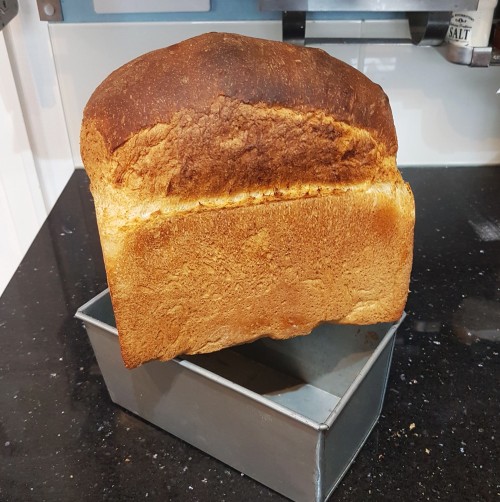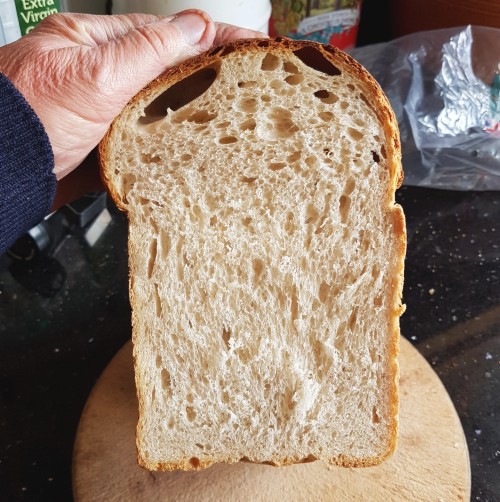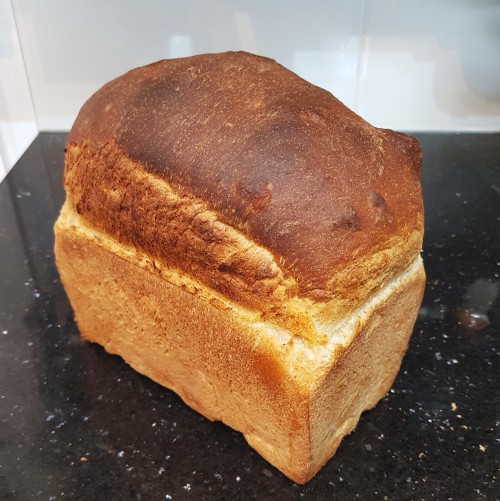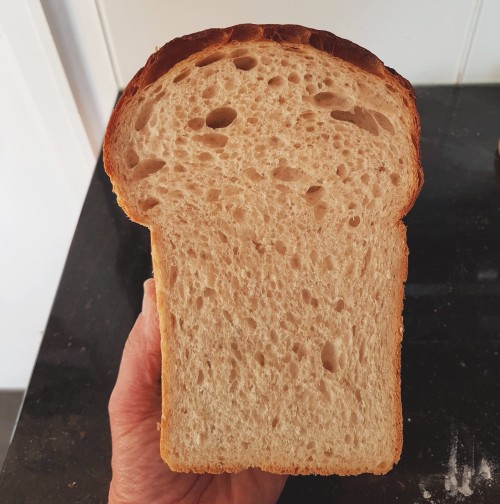October 17, 2018 - 2:20pm

A Big Tin Loaf

I chanced upon a long TFL post Chasing thin, crispy, not thick/tough dough A comment by Mariana regarding a 100% sponge method loaf caught my eye. I think Mariana made it in a bread machine, but the loft was incredible. I've been thinking of making a tin loaf for a while, so this was the perfect opportunity.
It's a yeasted dough, but I did a couple of tweaks to add some extra flavour: addition of 10% Mockmilled whole wheat flour and addition of 13% leftover stiff levain I had in the fridge. Overall hydration was 64%, plus the butter.
Initial mix
- 270g Duchy bread flour
- 270g Waitrose Canadian bread flour
- 60g Mockmilled whole wheat flour
- 1.5g diastatic malt
- 24g warm butter
- 3g IDY
- 0.03g ascorbic acid
- 80g levain @ 56%
- 324g warm water
Later Additions
- 12g salt (1.8%)
- 12g honey
- 24g dried skim milk powder
- 64g water
Process
- IDY creamed with 24g water at 40C
- 64g boiling water poured onto honey and skim milk powder - mix and allow to cool
- 300g water in mixer, add AA, then flours, levain, creamed IDY, malt, butter
- Mix lightly - no gluten development
- Rest for 3hrs 40 mins
- Add honey/milk mix and mix in on slow, then add salt and mix in
- Develop gluten - 5 mins on high speed
- Bulk ferment at 28C for 30 mins
- Shape to 1 x 900g tin loaf plus a very small "leftovers" loaf
- Final proof 1 hour at 28C - dough nearly at top of tin.
- Bake in oven at 230C with steam for around 50 mins until internal temp 95C
Thoughts
- A crazy big loaf - I don't think i've ever made a taller one! Height was 185mm/7.25"
- Nice crumb - not too open, which wouldn't have been appropriate, but not tight.
- Mild but pleasant flavour.
- Probably not a type of loaf I will make on a regular basis, but a nice occasional style.




Lance


Comments
Just the way a bloomer should look! I see some fine sandwiches coming your way. Well done and happy baking
and is the crust thin and crispy? the crumb looks lovely and soft.
Did the entire top come from ovenspring? it looks as if it did. agreat occasional bake.
Leslie
The crust wasn't as crisp as I wanted, due to poor steaming; I normally have a "steaming apparatus" above the bakestone, just under the top oven element, but I suddenly realised that there wasn't going to be any room for it if I got a lot of oven spring (which I did), so I had to take it out and just sprayed some water in.
The dough was nearly up to the top of the 100mm/4" tin when I baked, so I guess you could say the oven spring was 85%!
The loaf was an ideal shape for a fried egg buttie, as we call them round here. As a bonus, the extended "form factor" of the loaf meant that you could get two eggs in!
Lance
Very nice Lance.
Sometimes an improved pan loaf is the way to go. Good luck getting those slices in a toaster!
I like the clear and concise approach you've taken. A grand bake indeed!
Michael
Yes, even the Dualit toaster needed the double toasting technique.
Thanks for your positive comment on layout - I guess it's my scientific background showing through!
How's the Oenology course going?
Lance
Hi Lance,
The course is going alright. Learning at this level (BSc) it is quite challenging. But it's all good, lots to learn with plenty of practical work. As a second year student we get to process the grapes in the winery. Each week I'll be doing things like pumping over tanks, weighing out enzyme and SO2 addition (PMS), loading the press... There is a lab session every week too.
There was a segment on the BBC South East Inside Out programme featuring my fellow students. I'm lurking in the background of various shots.
Cheers,
Michael
I watched it Michael; it looks like an interesting course, but you seem to be very elusive!
A couple of questions:
Interesting that some of the big Champagne houses now have plots in the South East and Hampshire. And one house has recently released an English sparkling wine.
Lance
Sulphur dioxide (SO2) has numerous properties. It is an anti-oxidant, anti-microbial, anti-oxidasic, anti-aldehyde. SO2 is often added to the must prior to inoculation especially when making white wine to help stabalise it. Oxidation causes browning. Wine yeasts have a degree of tolerance to SO2 so it actually helps to favour them.
Red wine is different since the skins which are in included in the must, have natural anti-oxidant properties.
We add different forms of pectinase to help homogenise the juice as this will effect the performance of the yeasts.
I hope that was enlightening,
Michael
Thanks! A lovely loaf, will try this soon. I love to make large, long multi-grain loaves for my helpful neighbors with 3 hungry kids (with smaller loaf for us). Parents are an E.R. nurse & doctor who want me to teach them bread-making, but are so busy. They're my eager recipe testers; the youngest will run up my hill before I hang up the phone offering a fresh bake.